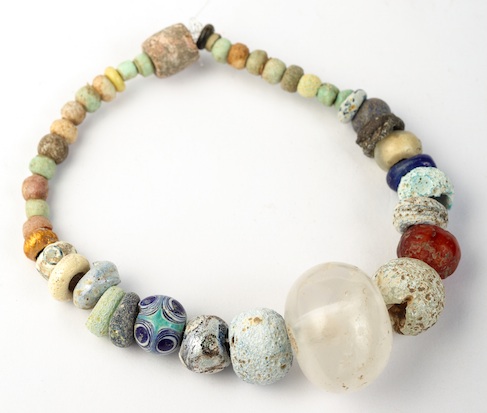Glass paste necklace beads
Various multi-coloured glass paste necklaces were found in the tombs of the Punic necropolis of Sulky.
The majority of those now on display in the museums have mostly been recomposed and, therefore, we do not know their original composition. The most common beads (i.e. the components of the necklace) are mostly spherical with a glass thread decoration of different colours, obtained by adding mineral oxides to the elements that make up the glass (fig. 1). The most used decoration is the loop one, then there are also those with polka dots, parallel lines and in relief. A few beads have an elongated, tubular, cylindrical or "acorn" shape (fig. 2). In some cases, the glass paste was used to mimic the stones, should the stones not be available (fig. 3).



Necklaces could also consist of pendants shaped as a human face, and one of the best examples comes from Sardinia, and precisely from Olbia (fig. 4).
What was the function of these necklaces which were found in such large numbers in Phoenician and Punic tombs? They were placed on the deceased, probably at chest height, at the time of deposition. These beads, often decorated with many small eyes, and with figured pendants, had an apotropaic function, i.e. they were protection for the deceased who was about to undertake the journey from his tomb to the afterlife, reinforcing the protective role played by amulets and masks.
As for the technical manufacture, the beads and configured pendants together with the balsam-holders also used the "sand or clay core-forming" method, which consisted in creating a model of soft and crumbly material, dipping it in molten glass to obtain the object in the desired shape, then decorating it and adding the various details. The use of moulds was common for creating figured pendants.

Bibliografia
- R. D’ORIANO, A. SANCIU, La sezione Fenicio-Punica del Museo “G. A, Sanna” di Sassari, Piedimonte Matese 2000.
- M.L. UBERTI, I vetri in AA. VV., I Fenici, Milano 1988.

 VR
VR